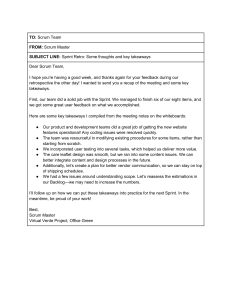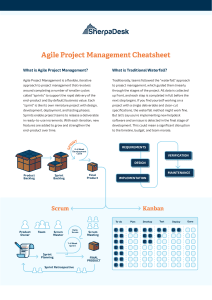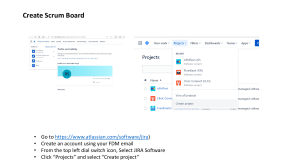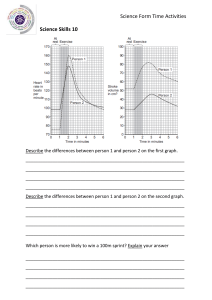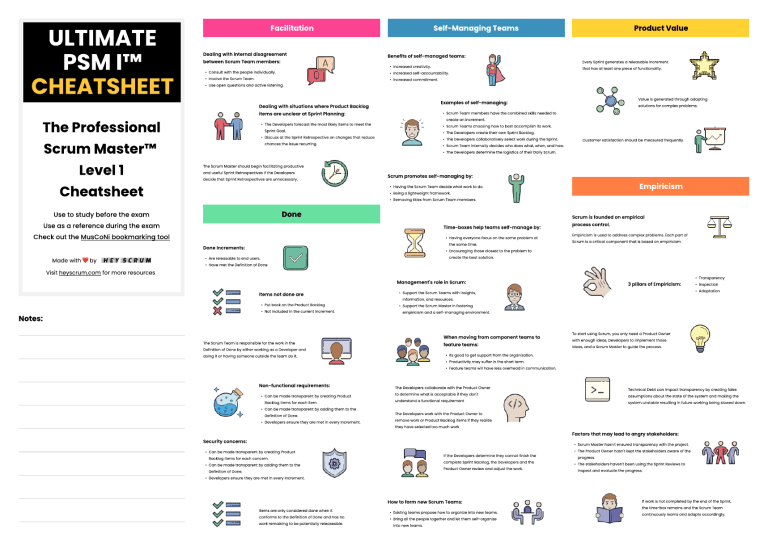
ULTIMATE PSM I™ CHEATSHEET Dealing with internal disagreement between Scrum Team members: Consult with the people individually Involve the Scrum Team Use open questions and active listening. Benefits of self-managed teams: Increased creativity Increased self-accountability Increased commitment. Scrum Team members have the combined skills needed to create an Increment Scrum Teams choosing how to best accomplish its work The Developers create their own Sprint Backlog The Developers collaboratively select work during the Sprint Scrum Team internally decides who does what, when, and how The Developers determine the logistics of their Daily Scrum. The Developers forecast the most likely items to meet the Sprint Goal Discuss at the Sprint Retrospective on changes that reduce chances the issue recurring. The Scrum Master should begin facilitating productive and useful Sprint Retrospectives if the Developers decide that Sprint Retrospectives are unnecessary. Scrum promotes self-managing by: Having the Scrum Team decide what work to do Being a lightweight framework Removing titles from Scrum Team members. Done Use to study before the exam Use as a reference during the exam Check out the MusCoNi bookmarking tool Time-boxes help teams self-manage by: Having everyone focus on the same problem at the same time Encouraging those closest to the problem to create the best solution. Done Increments: Made with ️by Visit heyscrum.com for more resources Are releasable to end users Have met the Definition of Done Management's role in Scrum: Items not done are Put back on the Product Backlog Not included in the current Increment. Notes: Support the Scrum Teams with insights, information, and resources Support the Scrum Master in fostering empiricism and a self-managing environment. When moving from component teams to feature teams: The Scrum Team is responsible for the work in the Definition of Done by either working as a Developer and doing it or having someone outside the team do it. Non-functional requirements: Can be made transparent by creating Product Backlog items for each item Can be made transparent by adding them to the Definition of Done Developers ensure they are met in every Increment. Every Sprint generates a releasable Increment Value is generated through adapting solutions for complex problems. Customer satisfaction should be measured frequently. Empiricism Scrum is founded on empirical process control. Empiricism is used to address complex problems. Each part of Scrum is a critical component that is based on empiricism. 3 pillars of Empiricism: Transparenc Inspectio Adaptation To start using Scrum, you only need a Product Owner with enough ideas, Developers to implement those ideas, and a Scrum Master to guide the process. Its good to get support from the organization Productivity may suffer in the short term Feature teams will have less overhead in communication. The Developers collaborate with the Product Owner to determine what is acceptable if they don't understand a functional requirement The Developers work with the Product Owner to remove work or Product Backlog items if they realize they have selected too much work Security concerns: Can be made transparent by creating Product Backlog items for each concern Can be made transparent by adding them to the Definition of Done Developers ensure they are met in every Increment. If the Developers determine they cannot finish the complete Sprint Backlog, the Developers and the Product Owner review and adjust the work. How to form new Scrum Teams: Items are only considered done when it conforms to the Definition of Done and has no work remaining to be potentially releaseable. Product Value that has at least one piece of functionality. Examples of self-managing: Dealing with situations where Product Backlog items are unclear at Sprint Planning: The Professional Scrum Master™ Level 1 Cheatsheet Self-Managing Teams Facilitation Existing teams propose how to organize into new teams Bring all the people together and let them self-organize into new teams. Technical Debt can impact transparency by creating false assumptions about the state of the system and making the system unstable resulting in future working being slowed down. Factors that may lead to angry stakeholders: Scrum Master hasn't ensured transparency with the project The Product Owner hasn't kept the stakeholders aware of the progress The stakeholders haven't been using the Sprint Reviews to inspect and evaluate the progress. If work is not completed by the end of the Sprint, the time-box remains and the Scrum Team continuously learns and adapts accordingly. Coaching & Mentoring Scrum Values M If a Developer informs the Scrum aster of a security issue, have the Developer share his concerns with the Scrum Team as soon as possible. Product Owners are coached to understand that the best architecture and infrastructure emerge alongside functional development and that each Sprint should include some business functionality. Scrum Values: For a Product effort with more than one Scrum Team, Scrum aster teaches the Developers that it is their responsibility to work with the other teams to create an integrated Increment that includes the work from all teams. Not building items with low business value is a sign of Focus, Respect, and Courage. M The Scrum aster coaches people who have concerns about progress that progress comes from inspecting an Increment at the Sprint Review. The Product Owner releases when it makes the most since. Doing your best is to do your best Helping other team members." M / x y g by s a Scrum aster ou can help a new team with startin : M z Pro uct ac log anagement , Ensuring the team understands the need for a Definition of Done Have the team members introduce themselves and their professional background Ask the Product Owner to discuss about the product and answer uestions. Scrum Values are affected by the lack of trust. If a Product Backlog item is blocked by an e ternal dependency, the Scrum aster will remind the Product Owner that his primary concern is the flow of value reflected in the ordering of the Product Backlog. It is ordered Continuously updated with the most recent insights Available to all stakeholders. d h Lea ers ip Styles If the Developers don t have the tools and infrastructure to completely finish Product Backlog items, the Scrum aster can have the Scrum Team establish a Definition of Done that is actually possible given the situation or coach the Developers to improve their skills, tools and infrastructure over time and adjust the Definition of Done accordingly. If a stakeholder asks the Developers to add an item to an active Sprint, they should inform the Product Owner so he can work with the stakeholder. M If the Product Owner is not collaborating with the Developers during the Sprint, the Scrum aster can coach the Product Owner on the value of Scrum and incremental deliver or have it as a discussion point at the Sprint Retrospective. M y P s a Scrum aster ou can help a roduct wner that has sta eholders who are unhapp with slow performance of the product : k M , y by kh d x g - Leadin a scaled Scrum effort: M z The Product Backlog refinement occurs: 1-2 In the preceding Sprints In the actual Sprint if not done in the preceding Sprints. M C Sta e ol ers & ustomers q Adding Non functional re uirements to the Product Backlog increases transparency. As a Scrum aster, you can help an organi ation that is new to scaling Scrum by ensuring the product has one Product Backlog and one Product Owner As a Scrum aster, you can help a group divide into multiple Scrum Teams by asking the people to divide themselves into teams. As a Scrum aster, you can help a group divide into multiple Scrum Teams by having the people consider how to ensure all teams have the right about of e pertise Understanding the Product, Product history, the Product Goal, and the Scrum framework can help groups decide on how to divide into teams. M O Coaching him on how to e press his concerns with the Scrum Team Encouraging him to put performance work on the Product Backlog. To maximize Product Backlog transparency: x M q A d B k M The Scrum aster helps the Product Owner to understand that the goal of ordering the Product Backlog is to ma imi e value. ' ' It is not mandatory to release every Sprint, Increments only need to be in a releasable state. Examples of Commitment: q If the Developers want to reduce the fre uency of the Daily Scrum, the Scrum aster can coach them on why the event is important or he she can learn why they want this and work with them to improve the event s outcome. A Is an estimate of the total work remaining for the Sprint Indicates when work remaining will likely be completed if no changes occur. The Product Owner should know the most about progress towards business objectives or releases. If the Developers realize that the workload being planned is more than they can handle: M Burndown charts: A) Respec B) Courag C) Commitmen D) Opennes E) Focus M They can remove or change selected items Ensure that the Product Owner is aware, start Sprinting, and monitor the progress. Forecasting & Release Planning Infrastructure and Architecture are added to the Product Backlog and addressed in early Sprints alongside with functional development. x If a Project anager is concerned about progress and money spent: M Share the Product Backlog Share the current impediments Share the forecast for the Sprint. y s a Scrum aster ou support actions that: A M , Security concerns can be made transparent by creating Product Backlog items for each concern. Improves the ability of Developers figuring out their own solutions Improves the ability of the Scrum Teams to produce integrated Increments. Most important stakeholder is the Product s users. ' Regardless of the number of teams working on a Product, there is only one Product Backlog and one Product Owner. Productivity of the original Scrum Team will likely decrease in the short term if new Scrum Teams are added to the same product. - Gradually transitioning from component teams to feature teams will create less disruption and allow the teams to discover how best to organi e towards more effective feature teams. z The Scrum Team can meet with Stakeholders at anytime during the Sprint. Made with ️by M z inimi ing dependencies is helpful when multiple Scrum Teams are working from the same Product Backlog. Events The Sprint: The purpose of every Sprint is to produce a releasable What to consider when establishing the Sprint timebox: The Sprint Backlog: The Scrum Master: The ability to go to market Is responsible for Scrum being adopted and used properly Is the Scrum Team's plan for the Sprin The level of uncertainty of the technology being used Keeps the Scrum Team working at its highest level by Is owned by the Developers as a whole The risk of being disconnected from stakeholders facilitating Scrum Team decisions and removing Is created during the Sprint Planning Being short enough to keep risk acceptable impediments Only needs to be defined enough by the Developers to create Being short enough to synchronize with other business events Facilitates interactions and decision making a forecast Being no more than one month in length. Facilitates inspection and adaptation opportunities. Includes any work (Tests, Use Cases, Tasks, User Stories, etc) Increment that has at least one piece of functionality Helps those outside the team with interactions with the Scrum Team A new Increment must be available by the end of every Sprin Teaches the Scrum Team how to keep events timeboxed Can include process improvements from the previous Sprint Retrospective Monitors communication and facilitate direct collaboration with and within the Scrum Is a living artifact that changes as new work or decomposition of work is identified Team. Items can be changed or removed It is best to have consistent Sprint lengths throughout development of the product. Cancelling Sprints: Multiple Scrum Teams working on the same Product can have different start dates A new Sprint starts immediately after the conclusion of the previous Sprint A Sprint can be cancelled if the Sprint Goal There is no Sprint 0 becomes obsolete There is no Hardening Sprint Only Product Owners can cancel a Sprint. There is no Release Sprint Lowering the frequency of the Daily Scrum will result in: Impediments being raised slower Discuss what can be done and how to do it The Sprint Backlog becoming less accurate Has the competencies and skills needed to turn the Product Lost opportunities to inspect and adapt the Sprint Backlog. Determines how work is performed during the Sprint. Determines when it is best to update the Sprint Backlog Is accountable for tracking the remaining work toward the Sprint Goal Is responsible for managing progress of work during a Sprint Ensures the Product Backlog items conform to the Definition of Done Is responsible for estimating the size of Product Backlog items. 15 minute timebox Must be attended by the Developers Managed by the Developers and the Developers decide how it should be run Scrum Master only needs to ensure that the Developers have the Daily Scrum and teaches them how to keep it within the 15 minute time-box. Sprint Is composed of additional features in a useable state that complement those delivered in previous Sprints. When multiple Scrum Teams are working on the same Product they must integrate their Increments The Definition of Done: Defines what it takes for an Increment to be releasable Prioritize the list and work on them in order Enhances the transparency of an Incremen Is created, owned, and managed by the Scrum Team Consult with the Scrum Team. important work to do next to progress towards the Should have a consistent location and time to reduce complexity Must be delivered in a releasable state by the end of the Alert management to the impediments and their impact The outcome is a shared understanding of the most Master to address. Must adhere and conform to the Definition of Done The Product Owner is accountable for deciding when to release an Increment. Accountabilities Considered a feedback loop The Increment: A Scrum Master that is overloaded with a list of impediments can: The Daily Scrum: Sprint Goal and new impediments for the Scrum the Product Owner review and adjust the work. Determines the amount of work selected for a Sprint 8 hour timebox for a one-month Sprin Output is the Sprint Backlog and Sprint Goal. If the Developers determine they cannot finish the complete forecast, the Developers and The Developers: Organizes the work required to meet the Sprint Goal There is no reason to delay the start of a Sprint. The Sprint Planning: Developers can work with the Product Owner to make changes or optimize the work Backlog items into a releasable Increment There is no phase inbetween consecutive Sprints necessary to achieve the Sprint Goal. Becomes more stringent as Scrum Teams mature Creates a shared undestanding of when work is complete. A Scrum Team consists of 3 accountabilities: Developer Is the amount of work required to be done to a Product The value of having one Product Owner per product: The Product Owner It clear who is accountable for the ultimate value of the product The Scrum Master The Scrum Team knows who determines the ordering in the Members do not need to be full-time, however, outcomes and Product Backlog performance are affected by their participation and availability It helps avoid barriers to communication and allows rapid decision making. The Sprint Review: Backlog item that is selected at the Sprint Planning. Provides transparency into what has been done at the end of the Sprint Creates transparency over the work inspected at the Sprint Review Affects the Product's cost of ownership Guides the Developers in forecasting a Sprint Backlog for the Sprint When multiple Scrum Teams are working on the same product, they must have a Definition of Done that makes their combined work potentially releasable. Considered a feedback loop 4 hour timebox for a one month Sprint The Sprint Goal: The Scrum Team: Is an inspect and adapt opportunity for the Scrum Team and Stakeholders Scrum does not recognize tester roles, everyone on the Scrum Consists of Developers, one Scrum Master, and The Scrum Team and Stakeholders inspect the product Team is responsible for quality. one Product Owner Increment and collect feedback on next steps. Typically 10 or fewer people Considered a feedback loop 3 hour timebox for a one month Sprint Is held at the end of each Sprint The Scrum Master can facilitate as requested or needed All Scrum Team members participate as a team member. Is an opportunity for the Scrum Team to assess its performance and improve itself Is to identify process improvements can be addressed as soon as possible or added to the Sprint Backlog of the next Sprint Discuss the way the Scrum Team does Sprint Planning Discuss skills needed to improve the Development Team's ability to deliver Discuss its Definition of Done Topics not appropriate: Upcoming Sprint Backlog and Product Backlog items" Events are over when a timebox expires. and overarching direction for the Sprint. Increment Artifacts Self-manages and decides how best to accomplish its work Develops functionality from beginning to end throughout all technical layers Membership can change as needed, while accounting the short term impact on productivity Is responsible for resolving team member conflicts Is responsible for removing people from the Scrum Team. The Product Backlog: Is an inventory of items to be done for the Product Grows, changes, and evolves as more is learned and reflects The Product Owner: Is one person, for one Product there is one Product Owner Is the Value Maximizer or Value Optimizer - optimizing the value of the work the Scrum Team does Ensures that the most valuable functionality is produced first. maximum amount of time. Provides the Developers a target, a focus, a common goal, Is cross-functional and optimized to work on all technical layers Consists of cross-skilled individuals who are able to contribute to deliver an Is accountable for the ordering of the Product Backlog Events are timeboxed and can take no more than a The Product Owner should come to the Sprint Planning with a craft the Sprint Goal. value each Sprint. Discuss methods of communication Discuss team relations Sprint Planning business objective in mind and work with the Scrum Team to Contains all the skills necessary for creating The Sprint Retrospective: Is created during the Sprint Planning and is an output of the Is responsible for clearly expressing Product Backlog items Can be influenced by a committee Is responsible for engaging with stakeholders Is responsible for answering questions the Developers might have about items in the Sprint Knows the most about progress towards business objectives or releases. what is needed to be most valuable One product has one Product Backlog and one Product Owner. Multiple Scrum Teams working on the same Product pull items from Made with ️by the same Product Backlog Is managed by one Product Owner Is ordered by whatever the Product Owner deems is most appropriate Can be ordered based on priority, value, dependencies, and risk The Product Owner has final say on the order Ordering can be delegated to others, however, the Product Owner remains accountable Top priority items are refined and understood by the Scrum Team such that a forecast can be made to achieve the Sprint Goal The Developers are responsible for estimating the size of the Product Backlog items after clarifying requirements with the Product Owner." Visit heyscrum.com for more resources


